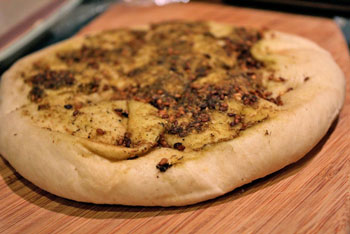It’s midway through feasting season and you’re thumbing through the end-of-the-year edition of MILL. That means it’s time for The Eater’s annual Food of the Year Award.
The chosen item can be any kind of food, but to be judged, it has to have a few key attributes – locally produced or grown, good for you, good for the environment and accessible in terms of both price and availability.
The Eater also tries to find items that are a worthwhile addition to one’s regular diet. Hard-to-prepare items or specialty foods just won’t do. Above all, of course, the Food of the Year has to be delicious.

This year, one product proved its worth in all of the above categories by making snacks and meals more wholesome and flavorful and affording those of us who are sometimes harried hosts a quick, easy-to-produce appetizer.
And the winner is (drum roll) … Mediterranean Deli’s Zaatar Pita!
This isn’t just any pita. Made in the ovens added by the deli a few years back during its big expansion, this bread is made from organic flour produced from local wheat at Lindley Mills in Graham. The ingredients list is positively ancient: organic wheat flour, water, thyme, sesame seeds, sugar, sumac, salt, citric acid and yeast. The thyme, salt and sumac provide a savory mix with the sumac adding a lemony tartness that is distinct but not overpowering.
The mix of flavors and the light, not-too-chewy bread are a perfect delivery system for a little hummus or ajar. (The Eater’s favorite midday snack is a toasted Zaatar Pita with a little soft cheese melted on it.) If you’re cutting up some pita for an appetizer or party snack, add the Zaatar variety to the mix.
Another key attribute that makes the Zaatar Pita this year’s champ is that it freezes well and cooks up quickly right out of the icebox.
A couple of things to keep in mind: Unlike the deli’s sesame and regular pitas, the Zaatar doesn’t produce an easy-to-open pocket, so it’s not as functional if you want to slice it in half and stuff it full of various ingredients. And some of the generous dusting of spices doesn’t always stay on the pita, especially after toasting, so it can be a little messier than the unseasoned varieties.
Also keep in mind when you’re buying pita from the deli that you’re supporting Lindley Mills’ efforts to revive the local wheat market. The mill, located along Cane Creek, was founded in 1755 and run by the Lindley family for a century. It was restored three decades ago to grind organic grains and has been an integral part of the effort to find varieties and a market for North Carolina farmers who want to diversify into wheat production.
If you haven’t tried this wonderful baked good, you’re in luck, because the deli has ramped up its production and distribution. You can buy it warm most days at the deli for $1.99 for a package of four, and fresh batches are in stock at all three Weaver Street Markets, along with Whole Foods and Fresh Market.
